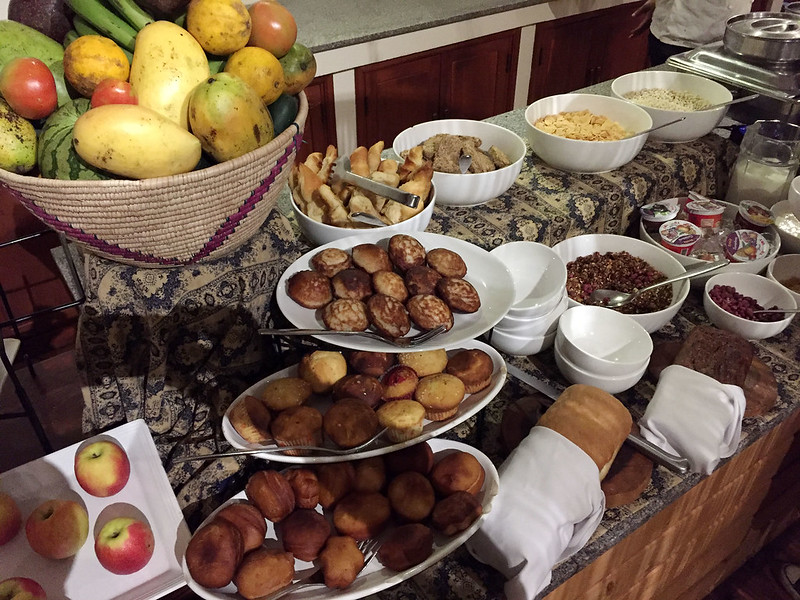
Last buffet breakfast at Acacia Farm Lodge
[ <<previous | index | next >> ]
21:06, Nimali safari camp, Serengeti National Park
We both woke early, and got up before the alarm went off. We dressed and were ready to go to breakfast by 06:00. Since they said they started serving breakfast from then, we walked down to the restaurant, only to find some surprised looking staff just finishing setting up the breakfast buffet. Obviously nobody had fore-warned them that guests would be arriving at 06:00. Godfrey in particular was missing, and we had visions of the other staff calling him and saying, "They're here already! Get down here ASAP!" He showed up at 06:30, as bright and cheerful as ever.
 Last buffet breakfast at Acacia Farm Lodge |
After finishing breakfast we returned to our room to use the bathroom and pack our bags to depart. We walked down to reception, at first pulling our wheeled bags behind us, but the noise quickly attracted the attention of a woman staff member who ran over and offered to take the bags for us. At reception we sat and used the WiFi until Timba arrived, at about 07:45. Since we were ready, we loaded up the car and left immediately. We thanked Godfrey for his personalised attention and I gave him a 50,000 shilling tip, which I hope was appropriate. The lodge staff ended our stay by singing a song of farewell as we departed.
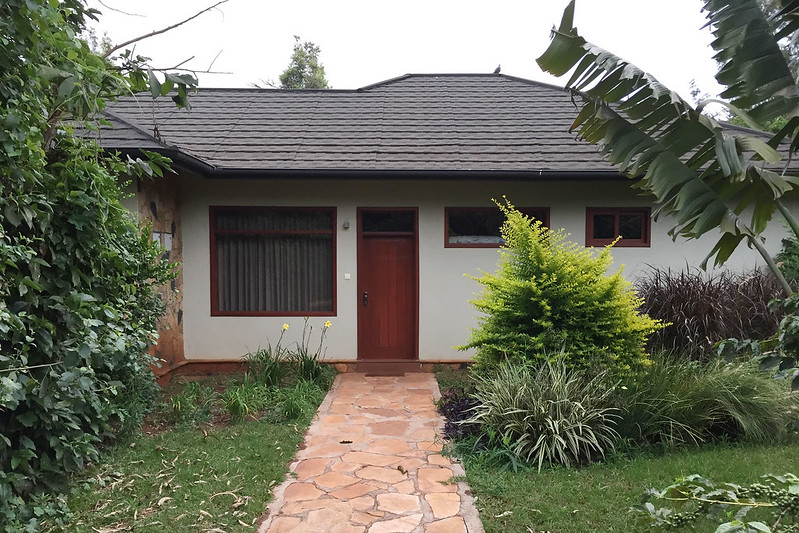 Goodbye to our bungalow room at Acacia Farm |
Timba drove us down the dirt road to the main road of Karatu once more, then turned right, to the west and Ngorongoro crater. We passed more Masai herders and groups of boys with faces painted black and white. One Maasai was leading a group of donkeys, which Timba said were "Maasai Land Cruisers". We soon reached the Ngorongoro Conservation Area gate, which was a literal gate spanned by a large arch, which the road went through, flanked by an administrative office on the right, and a visitor centre with gift shop on the left. There was also a toilet block to the left in a separate building. As we approached the gate, we saw a troop of baboons by the side of the road. At the parking area in front of the gate there were several cars already, and tourists milling about, some of them trying to get photos of the baboons without getting too close.
 Monkey with our car at the Ngorongoro entrance gate |
Timba said he had some paperwork to do to get our passes into the conservation area, and it would be about ten minutes, so feel free to use the toilets, check out the visitor centre, or just walk around. We did all three of these, but then Timba told us there was some problem with the paperwork and it would be a while longer. We ended up waiting maybe 20 minutes, but eventually it was sorted. In the meantime, dozens of other cars had approached the gates and/or driven through. Just before we left, a couple of large trucks had gone through as well.
 The Ngorongoro Conservation Area entrance gate |
We passed through the massive gate and it felt like entering Jurassic Park, as beyond was obviously another world. The road immediately changed from paved to heavily compacted dirt and narrowed considerably, and the terrain became steeper and more densely overgrown, with the jungle pressing harder on the road. We climbed quickly and soon came upon a queue of a few cars behind the two trucks, moving very slowly. We followed slowly for some time, as the land rose to meet the cloud base and the air became foggy. Eventually Timba overtook the slow vehicles, passing carefully on the narrow road, and we sped off, quickly gaining altitude. The fog grew thicker as we climbed.
 Fog, approaching the Ngorongoro crater rim |
Eventually we reached a lookout spot which was supposed to have a good view down into the crater, but it was so foggy it wasn't even worth stopping. We traversed the rim of the crater clockwise, with the land falling away into fog on both sides of the road. We passed the ascent road, where vehicles emerge after climbing from the crater floor, then later on we reached the descent road, both these being one way roads, so presumably very narrow with no room for passing. On the way there we spotted some wildebeest, and Timba explained that although most animals were confined to the crater floor, wildebeest and elephants could roam up to the rim. The crater descent road was a good way around the crater and by here the fog had lifted and we stopped to get our first view down to the crater floor, seeing the large lake down there, and some tiny dark specks that Timba said were animals. He said the crater floor was 600 metres below where we were standing. Although the inflow to the lake is fresh water, the lake is very salty, as it has no outflow.
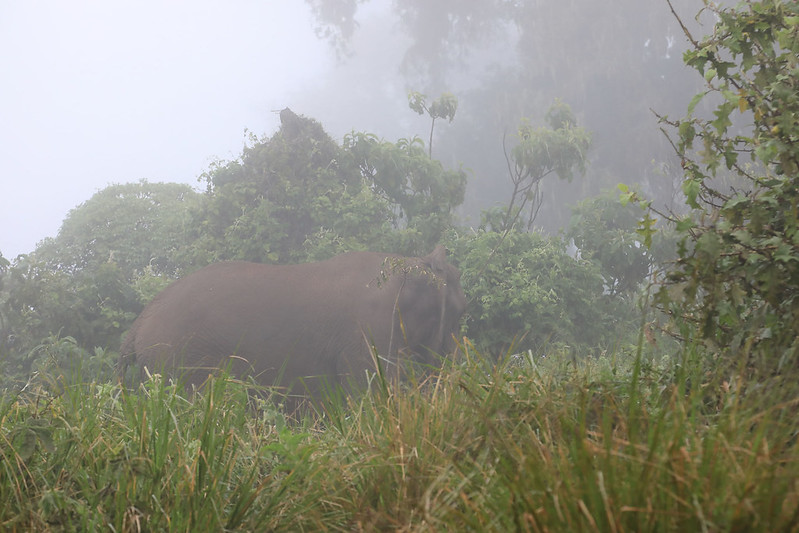 Elephant in the fog on the Ngorongoro crater rim |
But we weren't descending into the crater today. We continued driving, turning left away from the crater rim and back downhill to the surrounding plains. Here we saw zebra and wildebeest, and bit further along was a small lake where we saw flamingoes for the first time, both the greater and lesser. Timba said this wasn't a "real" lake - it only formed during the rainy season as rainwater collected here, but most of the time the valley floor is dry. Stretching out into a flat plain, the road now became more rocky and corrugated, and we rattled along at a good clip, passing through increasingly flat and dry looking terrain. The grass was now a brown colour and the trees faded away, leaving only the odd acacia tree now and then.
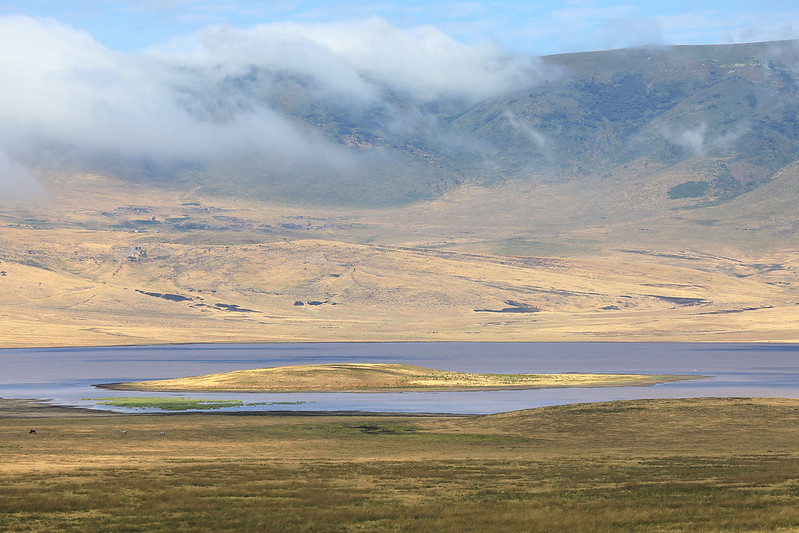 Rainwater lake in valley on flank of Ngorongoro crater rim |
And then there were none. The land stretched off to the far horizon in all directions, covered in waves of yellow grass, with nary a tree to be seen anywhere. A small clump of trees that we passed marked the border between Ngorongoro and Serengeti National Park, but the park entrance gate was several kilometres further on. Timba explained that "serengeti" in the local Maasai language means "endless plains". A very apt description.
 Giraffe and Maasai boys on the flat plain of Ngorongoro Conservation Area, just before Serengeti |
Twenty minutes later we stopped at the Serengeti entrance checkpoint at Naabi Hill, a small hilly outcrop in the middle of the flat plain. Again dozens of other cars were parked at this gate. This time there was something to do there, namely a short climb up a path to a lookout spot atop a clump of rocks. This gave us sweeping views of the Serengeti plains in all directions. We also saw agama lizards, with blue bodies and pink heads, and a couple of different birds, including the spectacularly coloured superb starling.
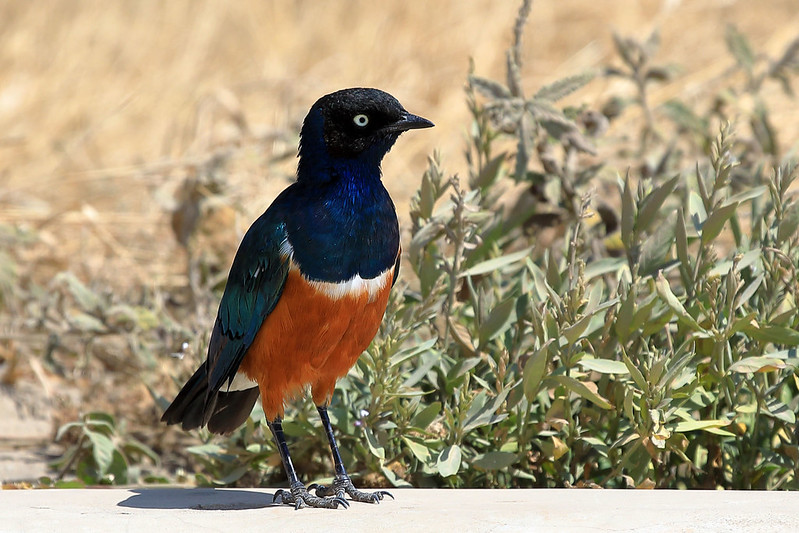 Superb starling, at Naabi Hill gate |
Paperwork done here more quickly, we continued driving deep into the heart of Serengeti, to our campsite for the next three nights, named Nimali. We drove pretty quickly to get there by lunch time, not stopping for animal sightings, but we saw zebra, giraffes, Thomson's and Grant's gazelles, and a few wildebeest. The road was pretty bad in places, and we got the famous "African massage" as the car rattled along the corrugated and potholed road. After some time, Timba turned off the main road onto smaller side trails, and took several turns that were not marked, until we were travelling along a simple pair of wheel ruts carved through the grass. I can't imagine how you'd ever find your way without either GPS or simple memory of all the trails.
 Nimali Central Serengeti camp, complete with zebra |
We arrived at Nimali, where the friendly staff took our bags to the dining tent so we could have lunch before settling into our room. The camp consisted of a dining tent, lounge tent, and just six accommodation tents. The lunch was a relatively simple affair compared to Acacia Farm. We had cold avocado and cucumber soup, followed by vegetable pizza and salad, then a fruit salad in a martini glass for dessert. We had a table for two, but it looks like all the other guests here are travelling together, as the ten of them all sat at one table and spoke Spanish with each other.
 View of surrounding landscape at Nimali camp |
After eating, we checked out our tent. It was pretty luxurious, having a king sized bed, writing desk, closets, and a large bathroom with solar hot water shower, twin sinks, and a flush toilet. There was electric lighting and power for plugging in things, though I don't know where that came from. There was no sound of a diesel generator to be heard, but perhaps it was located some distance away. We learnt that Timba was staying in a place around the other side of the small hill behind the tents, so maybe the generator was over there. They even had WiFi.
 Inside our tent at Nimali |
We rested a bit until 16:00, when we rejoined Timba for our first game drive in Serengeti, a short taster, returning by about 18:00 in time for dinner. But even on this short drive we saw zebras, wildebeest, hartebeest, Thomson's gazelles, Grant's gazelles, impala, dik-diks, topi, giraffes, elephants, baboons, a hyena, hippos, banded mongooses, and a leopard. The leopard was up a tree and barely visible, but several cars were crowded around to watch it. We could only see one ear and the top of its head, so who knows how anyone managed to spot it first and then attract a gaggle of cars. But before we saw the leopard we saw a tree with an impala slung over a branch; the kill of a leopard, but that leopard was nowhere to be seen. Timba said they stash their kills in a tree so no other predator will steal it, but then they can go wandering for a while before returning to finish it off.
 Thomson's gazelle |
We also saw many different types of birds. Timba spotted them and rattled off the names, occasionally pulling out his field guide for a trickier one. I didn't have time to take note of all the names and trusted that I could identify them from the photos when I got home. Adding them in to this diary later, birds I photographed on this day include: ostrich, greater flamingo, lesser flamingo, superb starling, rufous-tailed weaver, African grey flycatcher, Meyer's parrot, white-headed buffalo weaver, grey-backed fiscal, helmeted guineafowl, Rüppell's starling, Egyptian goose, magpie shrike, lilac-breasted roller, red-and-yellow barbet, red-cheeked cordon-bleu, blacksmith lapwing, black-headed heron, and gabar goshawk, plus some others I've yet to identify.
 Lilac-breasted roller eating a grasshopper |
We actually returned to the camp about 18:30, having seen so much stuff in a relatively short time. Timba said we'd leave at 07:30 tomorrow morning for a full day game drive, with a picnic lunch. We wished him a good night, then freshened up in our tent before heading out to sit by the bonfire a short distance from the dining room. The staff had hung lanterns in a tree and arranged chairs around the fire. It was beautiful in the African evening as the sunset gave way quickly to star spangled darkness. House drinks are included in our package, so M. got a red wine and I tried a Safari lager. It was nice, with a touch of sweetness and not bitter at all.
 Sitting by the evening campfire at Nimali |
The staff called us to dinner a bit after 19:00. Again it was us and the large Spanish table. Dinner was cauliflower and broccoli soup, presented in a two-tone manner side by side in one bowl with spots of red tabasco on top, followed by beef medallions (substituted by vegetables in a sauce for M.) with roast potatoes, carrots, and green beans, and then dessert of strawberry tart, which was strawberry pieces on shortbread with a white icing. The serving size was not large, which suited us fine.
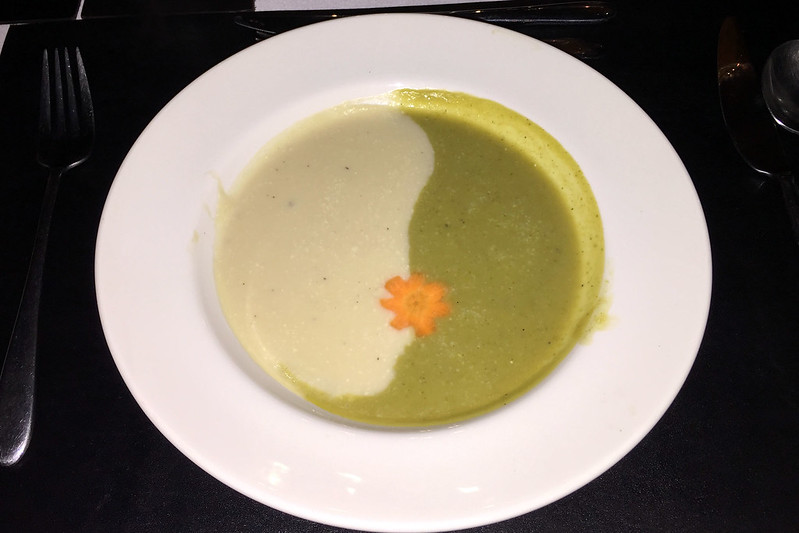 Two-tone cauliflower and broccoli soup |
After dinner we returned to our room, with an escort of two staff through the night for safety. One swung his torch back and forth, checking the grass and trees either side of the path for animals. We stopped partway to the room and said we'd like to look at the stars for a minute, as it's a good opportunity to see them in a dark sky area. It was a bit cloudy, but we saw plenty of stars. Then we went to the room, and discovered none of us had the key! We'd left it with someone when they asked so they could prepare our room for night time while we ate, and we hadn't got it back. So we waited and looked at more stars while one of the staff ran back to the dining area to get the key.
Inside we showered and set an alarm for 06:15, before climbing into bed. The evening was windy, and our tent made quite a bit of noise as it flapped around in the breeze. I hoped it wouldn't be so noisy all night, but thankfully the wind died down after a while. I wrote some diary until a bit after 22:00 then fall asleep.
[ <<previous | index | next >> ]